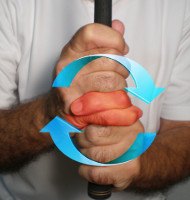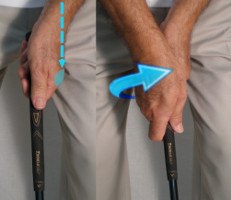Pros and Cons of Every Golf Grip Style |
Best Grip? Overlapping vs Interlocking |
Grip style: Interlocking |
Hand position: Neutral |
Putting grip style / hand position: Reverse overlap / neutral
|

He obviously has great hands, having briefly played basketball at Washburn University. So it makes sense that Gary Woodland’s grip would be a textbook model.
A two-time PGA TOUR winner from Topeka, Kansas, Woodland is one of the game’s best, most powerful athletes. The 6’1”, 195-pounder’s natural strength allows him to grip the club in a perfectly neutral position – as opposed to using a strong grip – and still rank among golf’s longest hitters. He’s typically in the tour’s top 10 at more than 300 yards per drive.
It’s hard to find fault with Woodland’s grip. His hands cradle the handle with minimal tension, the back of his left hand pointed toward the target. Trace a line from the “V” on his right hand (between thumb and index finger) and you’ll land just right of Woodland’s neck. Beautiful.
When putting, Gary Woodland’s grip is similarly sound. The actual grip on his putter is oversized, putting more of Woodland’s palms (vs. the fingers) in touch with the handle. He assumes a nice, neutral position and eases the blade back and through without wasted motion.
With belly and long putters all the rage – at least until 2016, when “anchoring” is outlawed – Woodland appears to go the opposite direction. His putter seems short relative to his height, which lets his arms hang freely and away from his body. Many golfers feel more comfortable with a shorter flat-stick, so give it a shot if you’re struggling on the greens.














